Scottish Crime and Justice Survey 2012/13: Drug Use
The report examines self-reported illicit drug use by adults aged over 16 in Scotland.
2 Prevalence of Illicit Drug Use in Scotland
2.1 Introduction
This chapter looks at the prevalence of illicit drug use in Scotland. The chapter examines overall trends in drug use reported to the SCJS between 2008/09 and 2012/13; variation in types of drug used; and socio-demographic and geographic variation in drug use. The chapter also examines the likelihood of being offered drugs and the prevalence of new drugs.
Chapter Findings
Self-reported drug use and trends over time
There has been a statistically significant decrease in self-reported illicit drug use in the last month, in the last year and ever between the SCJS 2008/09 and the SCJS 2012/13. The percentage of adults reporting taking one or more illicit drugs in the last year decreased from 7.6% to 6.2% of adults between 2008/09 and 2012/13. For those aged 16-59 only, reported drug use (in the last year) was similar in Scotland (8.5%) to England and Wales (8.2%) (Home Office, 2013).
Types of drugs reported
As in previous years, cannabis was the most commonly reported drug used by all adults: 5.1% of adults reported taking cannabis in the last year. The next most commonly reported drugs were cocaine (1.7%), ecstasy (1.3%), tranquilisers (0.8%), amphetamines (0.7%), and poppers (0.5%). There has been a statistically significant decrease in the number of adults reporting use of cannabis (-1.1 percentage points), cocaine (-1.0 percentage points), ecstasy (-0.5 percentage points) and tranquilisers (-0.4 percentage points) in the last year between 2008/09 and 2012/13.
Looking at drug use by legal classification, the SCJS 2012/13 found that 2.6% of adults reported use of Class A drugs; 5.3% of adults reported use of Class B drugs; and 1% of adults reported use of Class C drugs in the last year. There has been a statistically significant decline in reported use in the last year of Class A (-0.8 percentage points) and Class B (-1.1 percentage points) drugs between 2008/09 and 2012/13.
Variations in drug use
As in previous surveys, gender and age were found to be associated with illicit drug use with men and those aged 16-24 reporting higher levels of drug use in the last year. There has been a statistically significant decrease in the number of women reporting illicit drug use in the last year with 3.3% of women reporting taking one or more illicit drugs in the last year in the SCJS 2012/13 in comparison to 4.3% of women in 2008/09. There has been a statistically significant reduction of 7.1 percentage points from 23.5% to 16.4% of adults aged 16-24 reporting illicit drug use in the last year between 2008/09 and 2012/13. Self-reported illicit drug use was also significantly associated with socio-economic and geographic factors.
Being offered drugs
There has been a statistically significant decrease between 2008/09 and 2012/13 in those reporting that someone has offered to give or sell them at least one type of illicit drug in the last year with one in ten adults (10.6%) reporting that someone had offered to give or sell them at least one type of illicit drug in the last year compared with 13.7% in 2008/09.
New Drugs
There are six new drugs included in the SCJS 2012/13 (mephedrone and a new drugs category comprising BZP, GBL, synthetic cannabinoids, khat and salvia divinorum). 0.5% of adults reported having taken any of the new drugs - in the last year.
The SCJS 2012/13 provides estimates of the percentage of adults aged 16 or over who report that they have used illicit drugs based on answers provided for three periods of time: in the last month; in the last year; and ever. Comparisons with the previous three sweeps of the SCJS help to put these findings in context and reveals that the percentage of adults reporting using one or more illicit drugs has been declining. Table 2.1 and Figure 2.1 show this decline in the number of adults reporting illicit drug use for all three time periods used in the survey between the SCJS 2008/09 and the SCJS 2012/13.[10] The decline was significant comparing drug use reported in the 2008/09 survey with that reported in 2012/13. However, there were no statistically significant changes between 2010/11 and 2012/13. In the SCJS 2012/13:
- 3.3% of adults reported having used one or more illicit drugs in the last month (the month prior to the survey interview). This is compared with 4.4% in 2008/09, 4.2% in 2009/10 and 3.5% in 2010/11;
- 6.2% of adults reported having used one or more illicit drug in the last year. This is compared with 7.6% in 2008/09, 7.2% in 2009/10 and 6.6% in 2010/11;
- 23% of adults reported taking one of more illicit drug at some point of their lives (ever). This is compared with 25.6% in 2008/09, 25.2% in 2009/10 and 23.7% in 2010/11.
Table 2.1: % reporting use of any of the listed drugs and percentage change from SCJS 2008/09 and SCJS 2010/11 to SCJS 2012/13
SCJS 2008/09; SCJS 2009/10; SCJS 2010/11; SCJS 2012/13
| Percentage of all adults aged 16 and over | 2008/09 | 2009/10 | 2010/11 | 2012/13 | % change 2008/09 - 2012/13 | % change 2010/11 - 2012/13 |
|---|---|---|---|---|---|---|
| Ever | 25.6 | 25.2 | 23.7 | 23.0 | -2.6 | -0.7 |
| In last year | 7.6 | 7.2 | 6.6 | 6.2 | -1.4 | -0.4 |
| In last month | 4.4 | 4.2 | 3.5 | 3.3 | -1.1 | -0.2 |
| Base | 10,960 | 13,410 | 10,980 | 10,220 |
Base: adults aged 16 or over
Variable Names: QEVE_ANY, Q12M_ANY, Q1M_ANY
Note: data highlighted in bold indicates significant differences between sweeps see section 1.3.1 for further details
Figure 2.1: % reporting use of any of the listed drugs
SCJS 2008/09; 2009/10; SCJS 2010/11; SCJS 2012/13
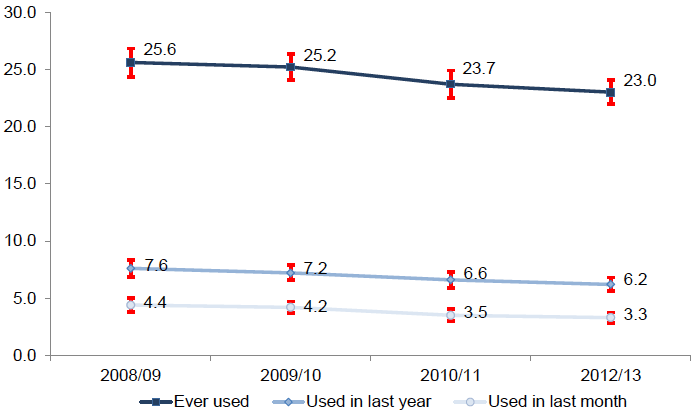
Base: adults aged 16 or over (2008/09: 10,960, 2009/10: 13,410, 2010/11: 10,980, 2012/13: 10,220)
Variable Names: QEVE_ANY, Q12M_ANY, Q1M_ANY
Note: Error bars represent a 95% confidence interval - see section 1.3.1
The findings from the SCJS 2010/11 showed that self-reported illicit drug use ever, for 16-59 year olds, was lower in Scotland (31.4%) in comparison with the findings from the British Crime Survey (2010/11) for England and Wales (36.3%). A comparison with the Crime Survey for England and Wales (2012/13) (formerly the British Crime Survey), for those aged 16-59 only, shows that reported drug use (in the last year) was similar in Scotland (8.5%) to England and Wales (8.2%) (Home Office, 2013). This contrasts with self-reported drug use at some point in their lives, for 16-59 year olds only, which was lower in Scotland (30.3% compared to 35.9% in England and Wales) (Home Office, 2013).
2.3 Self-reported drug use by composite group and by class of drug
2.3.1 Self-reported drug use by composite group
Figure 2.2 shows self-reported drug use by composite drug groups: stimulants, psychedelics, downers/tranquilisers and opiates.[11] Figure 2.2 shows:
- One in eight adults (12.3%, 535,000) reported that they had taken stimulant drugs at some point in their lives; 2.6% of adults (112,000) reported use of stimulants in the last year and 1% (44,000) in the last month.
- Around one in twelve adults (7.5%, 327,000) reported that they had used psychedelics at some point in their lives; 0.4% of adults (19,000) reported use of psychedelics in the last year and 0.1% (5,000) in the last month.
- 2.8% of adults (123,000) reported that they had used downers/tranquilisers at some point in their lives; 0.8% (33,000) of adults reported use of downers / tranquilisers in the last year and 0.3% (12,000) in the last month.
- 1.1% of adults (49,000) reported that they had used opiates at some point in their lives; 0.3% of adults (14,000) reported use of opiates in the last year and 0.2% (11,000) in the last month.[12]
There has been a statistically significant decrease in reported use of stimulant drugs in the last year with 2.6% of adults reporting use of stimulants in the last year in 2012/13 in comparison to 3.9% of adults in 2008/09. There was also a statistically significant decrease in the number of adults reporting use of downers/tranquilisers (-0.4 percentage points) and the use of psychedelics (-0.3 percentage points) in the last year between 2008/09 and 2012/13. There was no change in the number of adults reporting use of opiate drugs between 2008/09 and 2012/13.
Figure 2.2: % reporting use of drugs by composite group
SCJS 2012/13
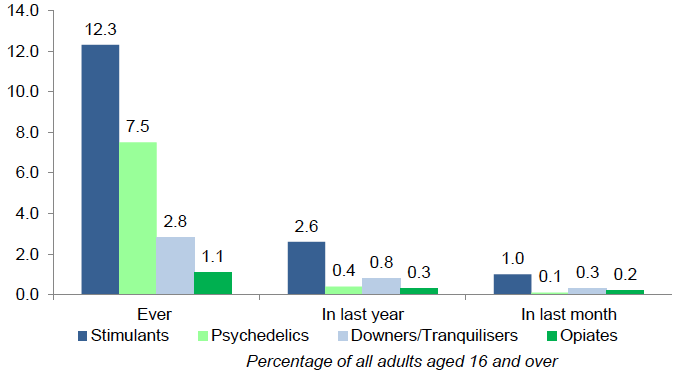
Base: Adults aged 16 or over (10,220)
Variable Names: QEVE, Q12M, Q1M
2.3.2 Self-reported drug use by legal classification
Figure 2.3 shows self-reported drug use by legal classification; Class A, Class B or Class C[13]:
- An estimated 12.9% of adults (561,000 people) reported having taken one or more Class A drugs at some point in their lives (ever); 2.6% (114,000) of adults reported that they had taken one or more Class A drugs in the last year and 1.1% (50,000) in the last month.
- An estimated 21.6% of adults (936,000 people) reported having taken one or more Class B drugs at some point in their lives; 5.3% (230,000) of adults reported that they had taken one or more Class B drugs in the last year and 2.8% (121,000) in the last month.
- An estimated 3.8% of adults (163,000 people) reported having taken one or more Class C drugs at some point in their lives; 1.0% (45,000) of adults reported that they had taken one or more Class C drugs in the last year and 0.4% (17,000) in the last month
Figure 2.3: % of adults aged 16 or over reporting use of drugs by legal classification ever, in the last year and in the last month
SCJS 2012/13
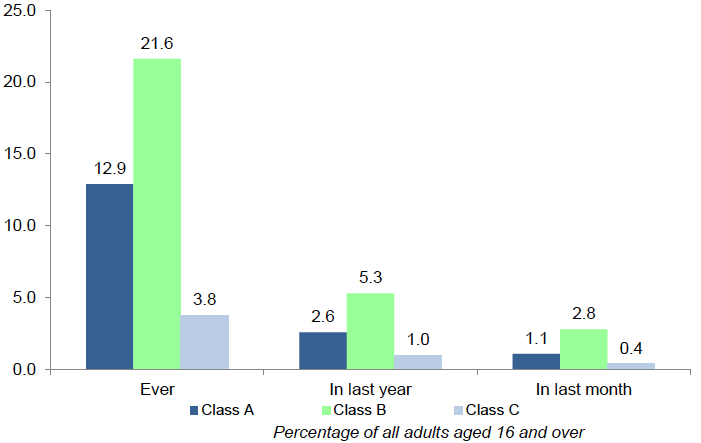
Base: adults aged 16 or over (10,220)
Variable Names: QEVE, Q12M, Q1M
Table 2.2 reveals a statistically significant decrease in reported use of Class A and Class B drugs in the last year between 2008/09 and 2012/13. The decline in reported use of Class C drugs between 2008/09 and 2012/13 was not statistically significant.
Table 2.2: Trends in % of adults reporting illicit drug use in the last year by legal classification from 2008/09 to 2012/13
SCJS 2008/09; SCJS 2009/10; SCJS 2010/11; SCJS 2012/13
| Percentage of all adults aged 16 and over using drugs in the last year | 2008/09 | 2009/10 | 2010/11 | 2012/13 | % change 2008/09 - 2012/13 | % change 2010/11 - 2012/13 |
|---|---|---|---|---|---|---|
| Class A | 3.4 | 3.0 | 2.6 | 2.6 | -0.8 | - |
| Class B | 6.4 | 6.2 | 5.7 | 5.3 | -1.1 | -0.4 |
| Class C | 1.3 | 1.3 | 1.2 | 1.0 | -0.3 | -0.2 |
| Base | 10,960 | 13,410 | 10,980 | 10,220 |
Base: adults aged 16 or over
Variable Name: Q12M
Note: Bold text indicates significant differences between sweeps, see section 1.3.1 for further details.
2.4 Self-reported drug use by specific drug
The SCJS 2012/13 findings revealed that cannabis was the most commonly reported drug used by all adults; this was also a key finding from the SCJS 2010/11. It was found that:
- 21.1% of adults reported taking cannabis at some point in their lives;
- 5.1% of adults reported taking cannabis in the last year; and
- 2.7% of adults reported taking cannabis in the last month.
For adults who had ever taken one or more illicit drugs at some point in their lives, the next most commonly reported drugs after cannabis were amphetamines (7.8%), ecstasy (7.8%), cocaine (7.2%), poppers (5.8%) and the psychedelic drugs: magic mushrooms (5.4%) and LSD (5.2%).
For adults who had taken one or more illicit drugs in the last year, the next most commonly reported drugs after cannabis were cocaine (1.7%), ecstasy (1.3%), tranquilisers (0.8%), amphetamines (0.7%), and poppers (0.5%).
For adults who had taken one or more illicit drugs in the last month, the next most commonly reported drugs after cannabis were cocaine (0.6%), ecstasy (0.3%), tranquilisers (0.3%), amphetamines (0.2%) and heroin (0.2%).
Figure 2.4 shows the % of adults reporting illicit drug use in the last year by specific drug in ranked order, from the drug most commonly used to the drug least commonly used. [14]
Figure 2.4: % reporting drug use in the last year by drug used
SCJS 2012/13
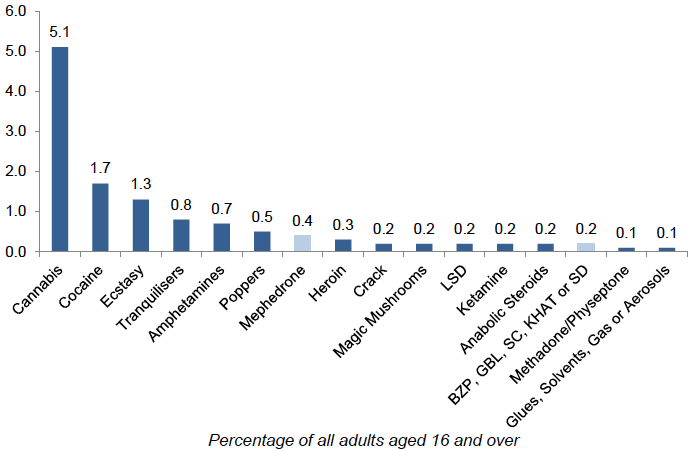
Base: adults aged 16 or over (10,220)
Variable Name: Q12M
Table 2.3 shows that there has been a statistically significant decrease in the reported use of cannabis, cocaine, ecstasy and tranquilisers in the last year between 2008/09 and 2012/13. In 2012/13, 5.1% of adults reported using cannabis in the last year in comparison to 6.2% in 2008/09. In 2012/13, 1.7% of adults reported using cocaine in the last year in comparison to 2.7% in 2008/09. In 2012/13, 1.3% of adults reported using ecstasy in the last year in comparison to 1.8% in 2008/09. In 2012/13, 0.8% of adults reported using tranquilisers in the last year in comparison to 1.2% in 2008/09.
Table 2.3: Trends in % of adults reporting use of cannabis, cocaine, ecstasy and tranquilisers in the last year from 2008/09 to 2012/13
| Percentage of all adults aged 16 and over using drugs in the last year | 2008/09 | 2009/10 | 2010/11 | 2012/13 | % change 2008/09 - 2012/13 | % change 2010/11 - 2012/13 |
|---|---|---|---|---|---|---|
| Cannabis | 6.2 | 6.1 | 5.6 | 5.1 | -1.1 | -0.5 |
| Cocaine | 2.7 | 2.1 | 1.9 | 1.7 | -1.0 | -0.2 |
| Ecstasy | 1.8 | 1.9 | 1.4 | 1.3 | -0.5 | -0.1 |
| Tranquilisers | 1.2 | 1.0 | 1.1 | 0.8 | -0.4 | -0.3 |
| Base | 10,960 | 13,410 | 10,980 | 10,220 |
SCJS 2008/09; SCJS 2009/10; SCJS 2010/11; SCJS 2012/13
Base: adults aged 16 or over
Variable Name: Q12M
Note: Bold text indicates significant differences between sweeps, see section 1.3.1.
2.5 Variations in self-reported drug use
2.5.1 Variation by gender
Self-reported drug use in the last month, in the last year and ever was significantly[15] associated with gender.[16] Men reported higher levels of illicit drug use than women (see figure 2.5 in section 2.6.2):
- 29.3% of men reported taking an illicit drug at some point in their lives in comparison to 17.2% of women;
- 9.4% of men reported taking an illicit drug in the last year in comparison to 3.3% of women;
- 5.3% of men reported taking an illicit drug in the last month in comparison to 1.6% of women.
Table 2.4 reveals a decrease in illicit drug use in the last year by women (-1.0 percentage points) and by men (-1.7 percentage points) between 2008/09 and 2012/13. The small decrease in percentage points between 2008/09 and 2012/13 for self-reported drug use by women in the last year was statistically significant. However, the decline in reported illicit drug use between 2008/09 and 2012/13 for men and the decline between 2010/11 and 2012/13 for both men and women were not statistically significant.
Table 2.4: Trends in reported illicit drug use in the last year by gender from 2008/09 to 2012/13
SCJS 2008/09; SCJS 2009/10; SCJS 2010/11; SCJS 2012/13
| Percentage of all adults aged 16 and over | Men (%) | Men (Base) | Women (%) | Women (Base) |
|---|---|---|---|---|
| 2008/09 | 11.1 | 4,800 | 4.3 | 6,160 |
| 2009/10 | 10.1 | 5,910 | 4.5 | 7,500 |
| 2010/11 | 9.5 | 4,730 | 3.9 | 6,250 |
| 2012/13 | 9.4 | 4,420 | 3.3 | 5,800 |
| % change 2008/09 to 2012/13 | -1.7 | -1.0 | ||
| % change 2010/11 to 2012/13 | -0.1 | -0.6 |
Base: adults aged 16 or over
Variable Name: Q12M
Note: Bold text indicates significant differences between sweeps, see section 1.3.1.
2.5.2 Variation by age
Self-reported drug use in the last month, in the last year and ever was significantly[17] associated with age.[18] Dividing the survey respondents into four age groups, it was found that the youngest age groups (16-24 years and 25-44 years) had the highest levels of self-reported drug use for all three time periods (see figure 2.5):
- 25-44 year olds had the highest reported level of illicit drug use at some point in their lives (39%) in comparison to 31.2% of 16-24 year olds; 18.9% of 45-59 year olds; and 4.3% of adults aged 60 or over;
- 16.4% of 16-24 year olds reported taking an illicit drug in the last year decreasing to 9.7% of 25-44 year olds; 2.5% of 45-59 year olds; and 0.3% of those aged over 60;
- 8.4% of 16-24 year olds reported taking an illicit drug in the last month decreasing to 5% of 25-44 year olds; 1.7% of 45-59 year olds and 0.3% of those aged over 60.
Figure 2.5: Variation in drug use ever, in the last year and in the last month by gender and age
SCJS 2012/13
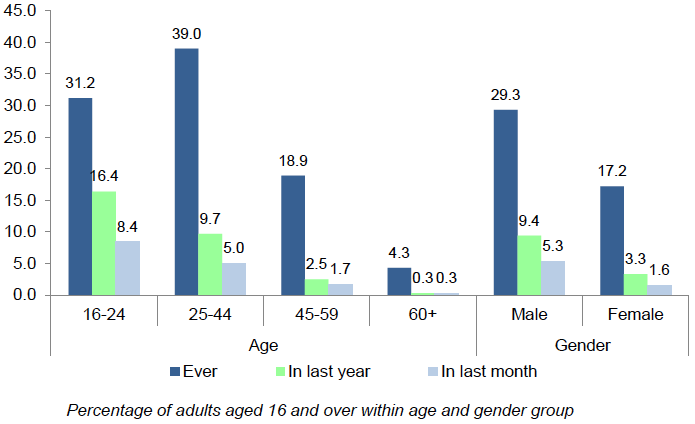
Base: adults aged 16 or over with age and gender group (16-24 860; 25-44 3,100; 45-59 2,730; 60+ 3,540; Male; 4,420 Female; 5,800)
Variable Names: QEVE_ANY, Q12M_ANY, Q1M_ANY
Figure 2.6 shows a statistically significant decrease in reported use of illicit drugs in the last year by 16-24 year olds between 2008/09 and 2012/13.
- 16.4% of 16-24 year olds reported taking any illicit drug in the last year in the SCJS 2012/13 signalling a downward trend from the previous SCJS surveys where 23.5% of 16-24 year olds in 2008/09, 20.2% of 16-24 year olds in 2009/10 and 20.3% of 16-24 year olds in 2010/11 reported taking any illicit drug in the last year. This represents a statistically significant reduction of 7.1 percentage points between 2008/09 and 2012/13.
- There were no statistically significant changes in reported drug use by other age groups in the last year.
Figure 2.6: Trends in reported drug use in the last year by age from 2008/09 to 2012/13
SCJS 2008/09; SCJS 2009/10; SCJS 2010/11; SCJS 2012/13
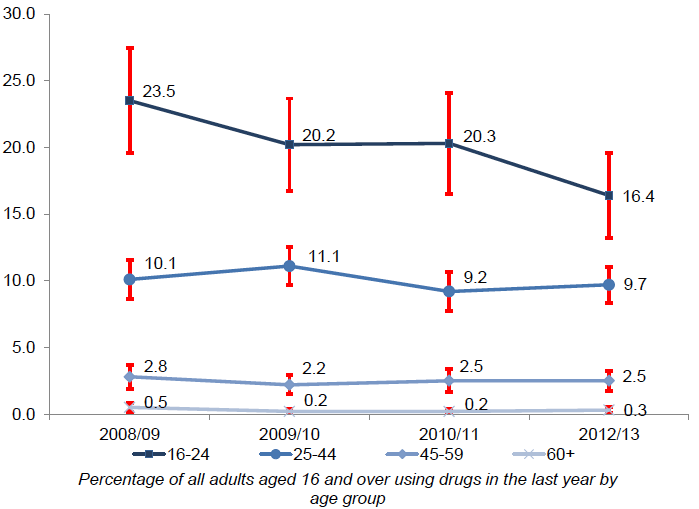
Base: adults aged 16 or over[19]
Variable Name: Q12M, TABAGE
2.5.3 Variation by age and gender
For both sexes, the highest level of reported illicit drug use in the last year was for the youngest age group with 22.1% of men and 10.5% of women aged 16-24 reporting illicit drug use in the last year. Reported illicit drug use decreased for both men and women as they got older (see figure 2.7).
Figure 2.7: Variation in drug use in the last year by gender and age
SCJS 2012/13
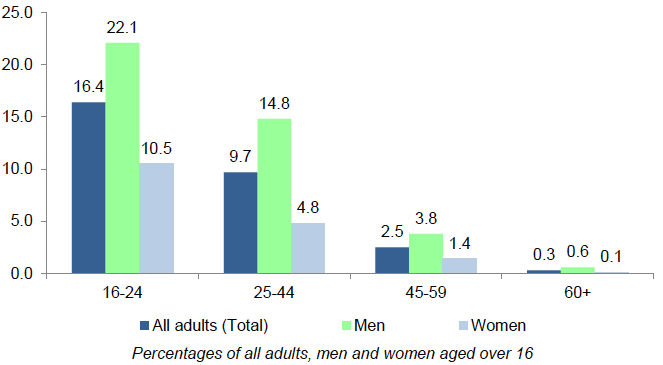
Base: adults aged 16 or over in each age group by gender (All adults (Total) 10,220; Men 4,420; Women 5,800)
Variable Name: Q12M
2.5.4 Variation in drug use by other factors
Self-reported drug use in the last year was significantly[20] associated with socio-economic classification[21]; housing tenure[22]; urban/rural classification; victim status[23] and area deprivation. The strongest differences in self-reported drug use in the last year were in relation to housing tenure[24] (see figure 2.8).
- Those classified in the routine and manual socio-economic group were more likely to report drug use in the last year (8.6% compared to 6.2% in the intermediate occupation group and 5.3% in the managerial and professional group). Of those classed as 'never worked and long-term unemployed' - 4.7% reported illicit drug use in the last year.
- Those who own their own property were less likely to report using illicit drugs in the last year (3.5% compared to 12.2% who privately rent and 10.5% who rent socially).
- Those who live in urban areas were more likely to report using illicit drugs in the last year (7% compared to 2.7% of those living in rural areas).
- Victims of crime were more likely to report using illicit drugs in the last year (10.8% compared to 5.2% of non-victims).
- Those classified as living in the 15% most deprived areas based on the Scottish Index of Multiple Deprivation[25] were more likely to report using illicit drugs in the last year than those not living in the 15% most deprived areas (8.8% compared to 5.7%).
Figure 2.8: % reporting illicit drug use in the last year by socio-economic group, housing tenure, urban/rural location, victim status and SIMD Index
SCJS 2012/13
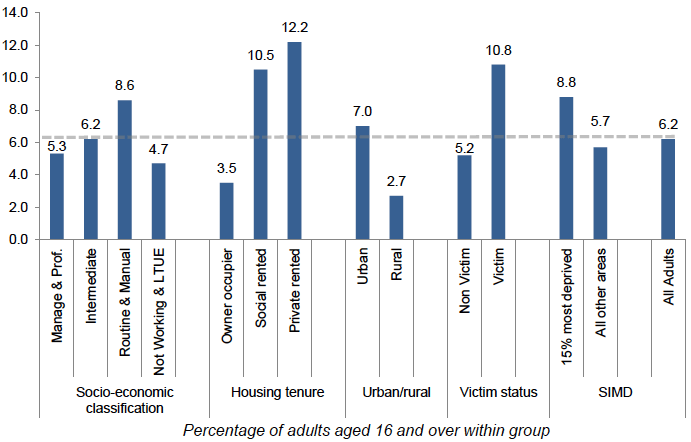
Base: adults aged 16 or over in group[26]
Variables Names: Q12M_ANY; TABNSSEC; TABTEN; TABURBRUR; VICFLAG3; SIMD_TOP
2.6 Being offered drugs in the last year
The SCJS 2012/13 estimated that around one in ten adults (10.6%) reported that someone had offered to give or sell them at least one type of illicit drug in the last year. Comparing this to previous sweeps of the SCJS reveals a statistically significant decline in those reporting that someone had offered to give or sell them at least one type of illicit drug in the last year with 13.7% of adults reporting being offered drugs in the SCJS 2008/09 and 11.6% in the SCJS 2010/11 (a drop of 3.1 percentage points).
Compared with previous sweeps of the SCJS, the SCJS 2012/13 found (see figure 2.10):
- 6.6% of adults reported being offered at least one stimulant drug in the last year signalling a statistically significant decline from the SCJS 2008/09 where 9.8% of adults reported being offered stimulant drugs (a fall of 3.2 percentage points);
- 1.3% of adults reported being offered tranquilisers/downers in the last year signalling a statistically significant decline in comparison to the SCJS 2008/09 (-1.5) and the SCJS 2010/11 (-1.0).
Figure 2.10 % being offered an illicit drug by composite group in the last year SCJS 2012/13 compared with previous sweeps
SCJS 2008/09; SCJS 2009/10; SCJS 2010/11; SCJS 2012/13
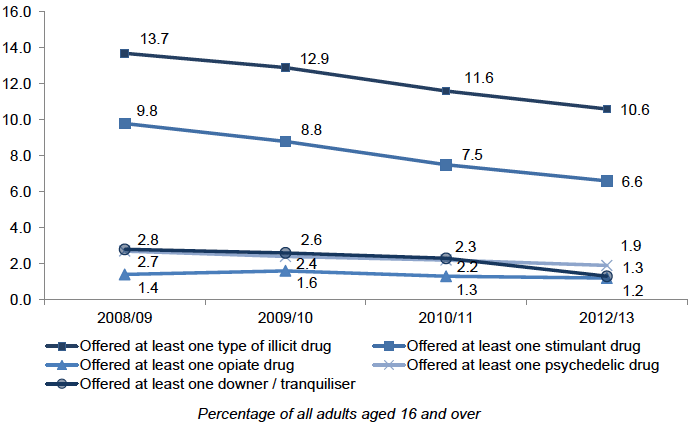
Base: adults aged 16 or over (2008/09 10,960, 2009/10: 13,410, 2010/11: 10,980, 2012/13: 10,220)
Variables Name: QOF2
Drugs legally classified as Class B were the most commonly reported to have been offered in the last year (8.6%). For all three types of drug class, comparisons with the SCJS 2008/09 reveal a statistically significant decline in adults reporting they have been offered drugs (Class A -2.5; Class B -2.4; Class C -1.1). There was also a statistically significant decline in adults reporting being offered Class C drugs between 2010/11 and 2012/13 (-0.7). This is part of an overall declining trend over the last 4 sweeps of the SCJS (figure 2.11)
Figure 2.11 % being offered an illicit drug by legal classification in the last year SCJS 2012/13 compared with previous sweeps
SCJS 2008/09; SCJS 2009/10; SCJS 2010/11; SCJS 2012/13
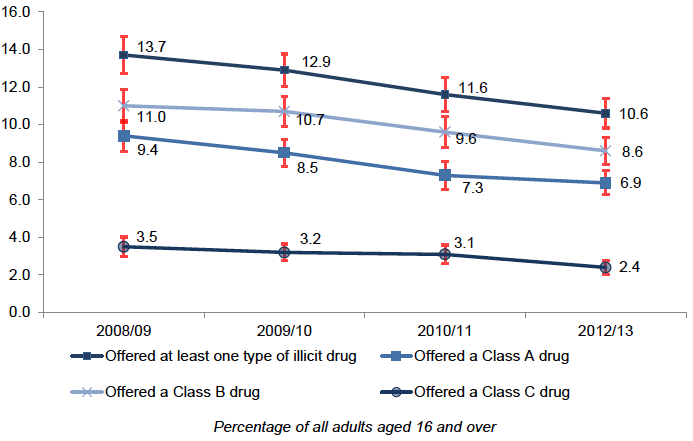
Base: adults aged 16 or over (2008/09 10,960, 2009/10: 13,410, 2010/11: 10,980, 2012/13: 10,220)
Variables Name: QOF2
Figure 2.12 shows the percentage of adults aged 16 or over who reported that someone had offered to give or sell them at least one type of illicit drug in the last year by composite drug group; legal classification of drugs; and the most commonly offered drugs (cannabis, cocaine and ecstasy).
Just less than one in ten adults (8.3%) reported being offered cannabis in the last year, 4.7% reported being offered cocaine and 4% reported being offered ecstasy. Comparing these figures with previous sweeps of the SCJS also revealed a statistically significant decrease between 2008/09 and 2012/13 (cannabis -2.0; cocaine -2.3; ecstasy -2.3).
Figure 2.12: % of adults aged 16 or over being offered drugs in the last year by type of drug
SCJS 2012/13
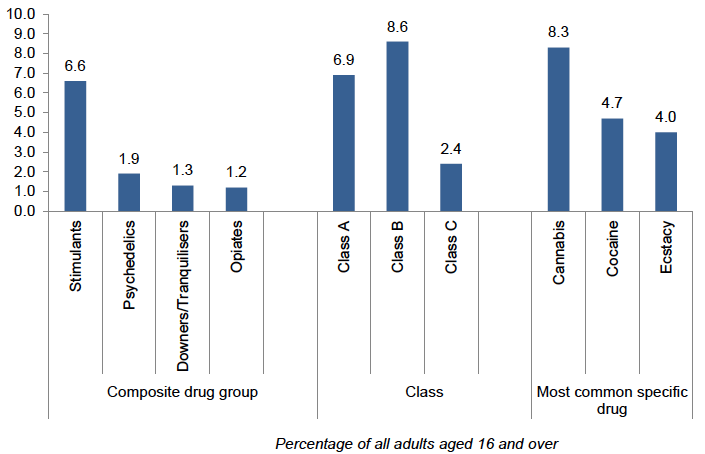
Base: Adults aged 16 or over (10,220)
Variable Name: QOF2
2.6.1 Variation in being offered drugs by gender
Bases: Men - 4,420; Women - 5,804
Men were more than twice as likely as women to report being offered an illicit drug in the last year (15.5% in comparison to 6.2%). Men were also more likely than women to report being offered each of the specific drugs.
2.6.2 Variation in being offered drugs by age
Bases: 16-24 - 859; 25-44 - 3,103; 45-49 2,727; 60+ 3,535
Over a quarter of 16-24 year olds (29.5%) reported being offered an illicit drug in the last year. In comparison, 15.5% of 25-44 year olds, 4.6% of 45-59 year olds and 0.9% of those aged over 60 reported being offered an illicit drug in the last year.
2.6.3 Variation in being offered drugs by other factors
Bases: Victim 1,602 Non-Victim 8,522; Manage & Prof 1,987; Intermediate 1,456, Routine & Manual 2,204, Not working and Long term Unemployed 3,768; Urban 8,114, Rural 2,110; Owner Occupier 6,513, Social rented 2,306, Private Rented 1,229; 15% most deprived areas 1,472, Remaining areas of Scotland 8,752.
Being offered drugs in the last year varied by socio-economic group, housing tenure, urban/rural classification, victim status and area deprivation.
- Those classified as working in the routine and manual occupations (15.6%) were more likely to have been offered illicit drugs in the last year than in any other occupation group (in comparison to 11.5% of the managerial and professional occupations group, 10.6% of the intermediate occupations group and 6% of those classed as not working or long-term unemployed).
- One in five of those who privately rent (20.8%) reported being offered illicit drugs in the last year, in comparison to 13.3% of those who socially rent and 7.7% of those who are owner occupiers.
- Those living in urban areas were almost twice as likely to report being offered illicit drugs in the last year compared to those living in rural areas (11.6% and 6.2% respectively).
- Victims of crime, as measured by the SCJS 2012/13, were more than twice as likely to have been offered illicit drugs in the last year as those who did not report being a victim of crime (18.5% and 9% respectively).
- Those classified as living in the 15% most deprived areas based on the Scottish Index of Multiple Deprivation were more likely to report being offered illicit drugs in the last year than those not living in the 15% most deprived areas (14.3% compared to 10%).
2.6.4 Variation in being offered drugs by drug use in the last year
Around one in ten adults (10.6%) reported that someone had offered to give or sell them illicit drugs in the last year. Of those who had not taken drugs in the last year, 6.4% said that they had been offered illicit drugs in the last year. This was also a finding in the SCJS 2010/11 and demonstrates that it is not necessarily the case that those reporting being offered illicit drugs would have actually used any illicit drug.
To ensure consistency with previous SCJS Drug Use reports, all new drugs were excluded from the main analysis in the rest of the report due to the small percentages involved. As previously mentioned, in the SCJS 2012/13 questionnaire, respondents were asked whether they had taken any of five drugs from a group of new drugs (BZP, GBL, synthetic cannabinoids, khat or salvia divinorum) and separately whether they had taken the new drug mephedrone. These same drugs were asked about in the 2010/11 survey, with the exception of salvia divinorum which was added for the first time in 2012/13.
- 2.3% of adults reported taking any of the new drugs ever in the SCJS 2012/13 in comparison to 1.8% in the SCJS 2010/11.
- 0.5% of adults reported taking any of the new drugs in the last year in the SCJS 2012/13 in comparison to 0.7% in the SCJS 2010/11
- 0.1% of adults reporting taking any of the new drugs in the last month in the SCJS 2012/13 in comparison to 0.2% in the SCJS 2010/11.
Self-reported use of new drugs ever varied significantly[27] by gender and by age. The strongest differences were in relation to age.[28] Of the 2.3% of adults who reported using any new drug ever (Base: 100), 3.6% of men reported using new drugs at some point in their lives in comparison to 1.1% of women. There were also variations in self-reported use of new drugs ever by age with the youngest age group (16-24) more likely to reported use of new drugs at some point in their lives (6.1%) in comparison to those aged 25 to 44 (3.8%) and those aged 45 to 59 (0.7%).
Whilst the percentage of adults ever using any of the new drugs has increased - the percentage of adults reporting use of the new drugs in the last year and in the last month has declined between 2010/11 and 2012/13. However, these changes were not statistically significant.
Similarly to the findings of the SCJS 2010/11, of the new drugs, mephedrone was the most commonly reported drug for all three time periods: 1.4% of respondents reported taking mephedrone ever; 0.4% reported taking it in the last year; and 0.1% reported taking it in the last month. Comparing this to the SCJS 2010/11 findings, whilst the percentage of adults reporting the use of mephedrone ever increased from 1.2% in 2010/11 to 1.4% in 2012/13 - the number of adults reporting use of mephedrone in the last year and in the last month has decreased (0.7% reported taking mephedrone in the last year and 0.2% reported taking mephedrone in the last month in the SCJS 2010/11). The decrease in the number of adults reporting use of mephedrone in the last year between 2010/11 and 2012/13 (-0.3) was the only statistically significant change amongst new drugs, however this finding should be treated with caution. The significance test found that the estimated change of 0.3 percentage points is on the borderline of significance at the 95% confidence level. In addition, it should be noted that the test is based upon survey estimates rounded to one decimal place (and indeed the tests also incorporate estimated survey design effects).
Contact
Email: Fran Warren
There is a problem
Thanks for your feedback